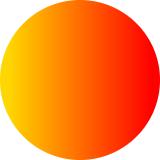Gradients support
1 Overview
1.1 Gradient stops
2 Linear gradient
2.1 Example
3 Radial gradient
3.1 Example
4 Limitations
5 Notes
1.1 Gradient stops
2 Linear gradient
2.1 Example
3 Radial gradient
3.1 Example
4 Limitations
5 Notes
Gradients can be defined in the
For example:


defs element[1]
. For example:
<linearGradient id="linearGradient4144" <stop offset="5%" stop-color="#F60" /> <stop offset="95%" stop-color="#FF6" /> </linearGradient>
Overview
The following attributes are supported for the both gradient specification types:-
id: the id of the gradient, to use in shapes which refer to this gradient -
xlink:href: the optional link to another gradient specification, allowing to reuse the Gradient stops specification from another gradient -
spreadMethod
Gradient stops
Each gradient specification can have one or several gradient stop children. Eachstop specifies one ramp of color for the gradient. A stop has the following attributes:-
offset: indicates where the gradient stop is placed -
stop-color: indicates the color of the stop -
stop-opacity: indicates the color opacity
style attribute.
Linear gradient
The following attributes are specifically supported for the linear gradient specification:-
x1andy1: the starting point of the gradient. If they are not specified, they will be assumed to be 0% -
x2andy2: the ending point of the gradient. If they are not specified, they will be assumed to be 100% forx2and 0% fory2
Example
The folllowing file:<svg viewBox="0 0 200 200" xmlns="http://www.w3.org/2000/svg" xmlns:xlink="http://www.w3.org/1999/xlink"> <defs> <linearGradient id="myGradient" gradientTransform="rotate(90)"> <stop offset="5%" stop-color="gold" /> <stop offset="95%" stop-color="red" /> </linearGradient> </defs> <circle cx="100" cy="100" r="80" fill="url('#myGradient')" /> </svg>Has the following result:

Radial gradient
The following attributes are specifically supported for the radial gradient specification:-
cxandcy: the center of the circle for the radial gradient -
r: the radius of the circle for the radial gradient -
fxandfy: the focal point for the radial gradient
Example
The folllowing file:<svg xmlns:svg="http://www.w3.org/2000/svg" xmlns="http://www.w3.org/2000/svg" xmlns:xlink="http://www.w3.org/1999/xlink" width="210mm" height="297mm" viewBox="0 0 744.09448819 1052.3622047"> <defs id="defs4"> <linearGradient id="linearGradient4138"> <stop style="stop-color:#bbe9ff;stop-opacity:1;" offset="0" id="stop4140" /> <stop id="stop4190" offset="0.53469652" style="stop-color:#15ea15;stop-opacity:0.77254903" /> <stop style="stop-color:#fff8bb;stop-opacity:0.5492537" offset="1" id="stop4142" /> </linearGradient> <radialGradient xlink:href="#linearGradient4138" id="radialGradient4204" cx="281.83255" cy="153.32645" fx="281.83255" fy="153.32645" r="179.297" gradientUnits="userSpaceOnUse" /> </defs> <g id="layer1"> <rect style="fill:url(#radialGradient4204);stroke:#000000;" id="rect4136" width="357.59399" height="105.05586" x="103.03556" y="100.79851" /> </g> </svg>Has the following result:

Limitations
- The
gradientUnitsattribute is not supported - The
gradientTransformattribute is not supported
Notes
×
![]()
Categories: fromsvgsupport